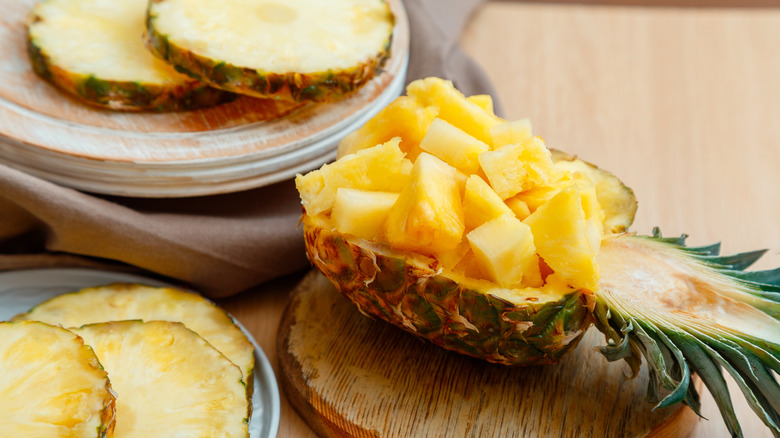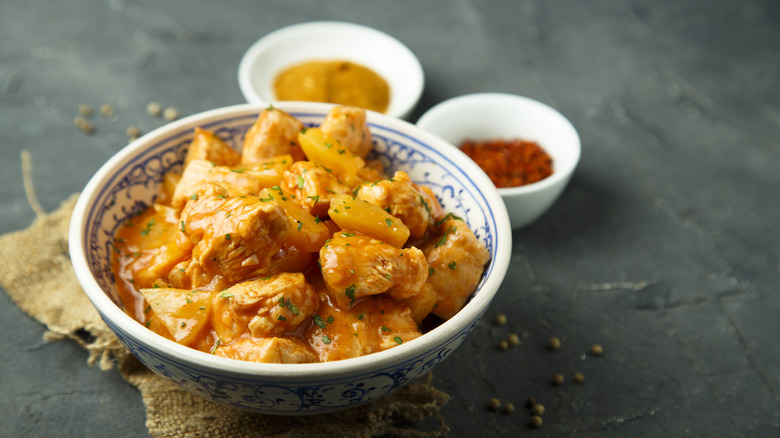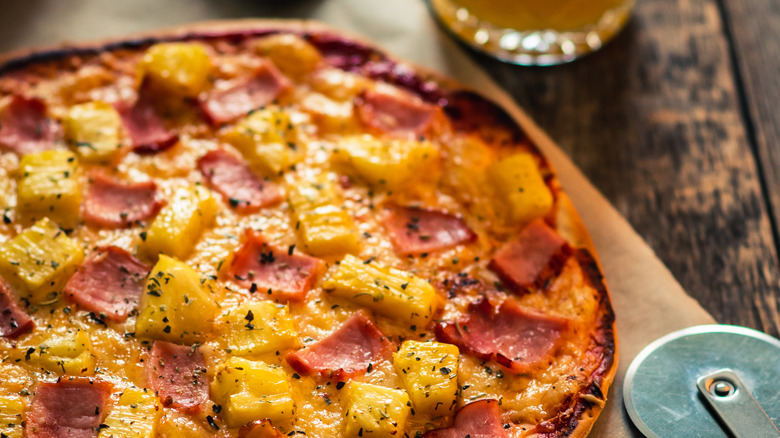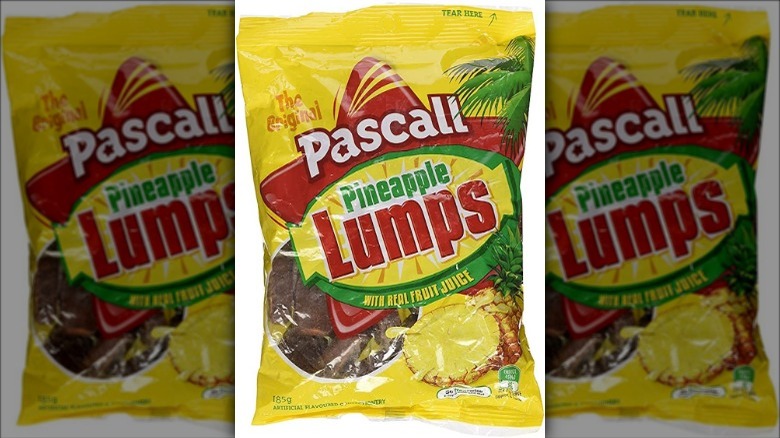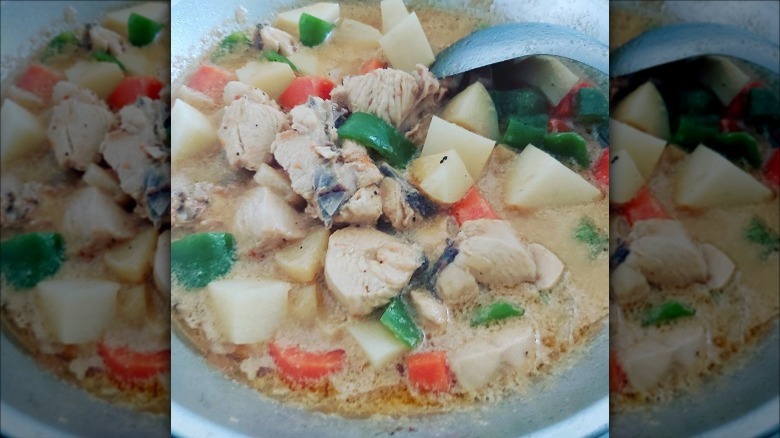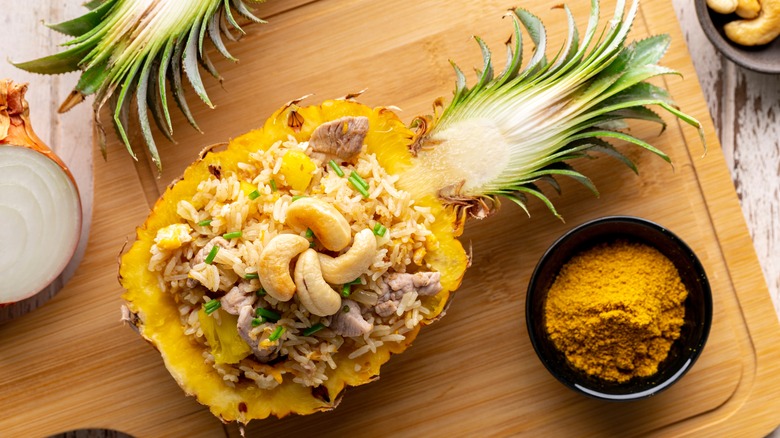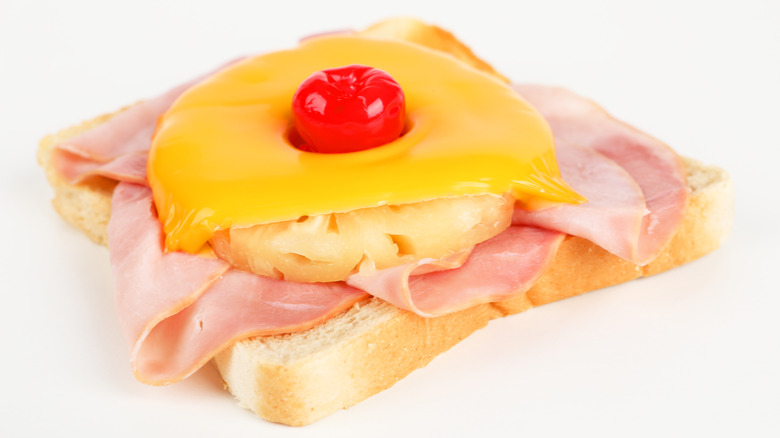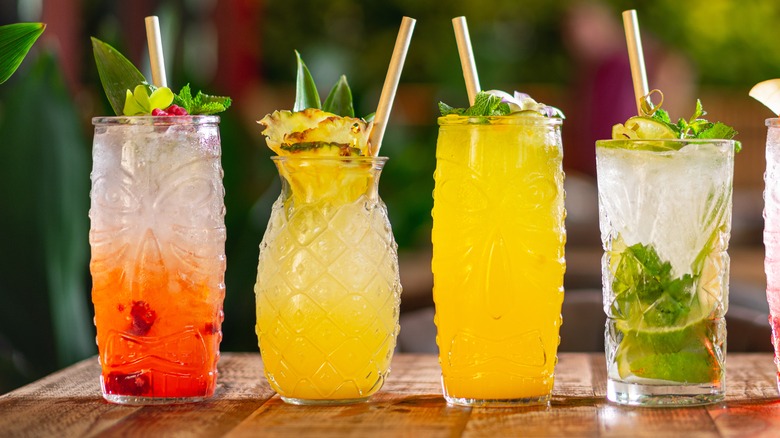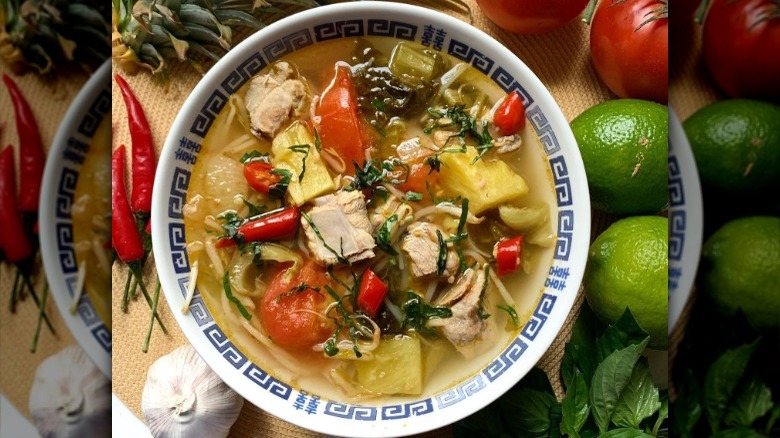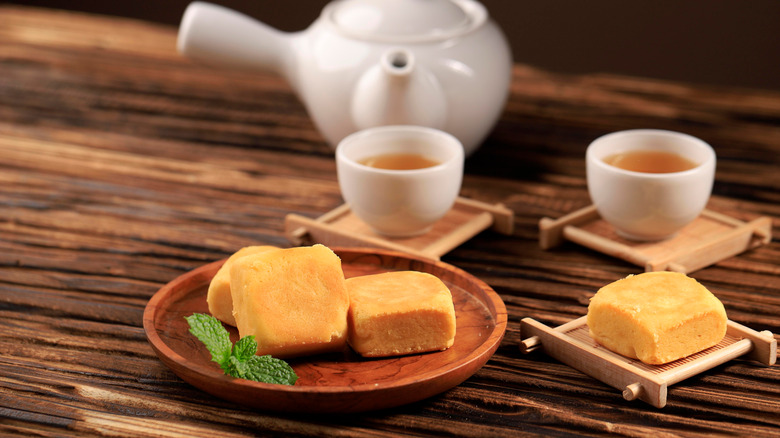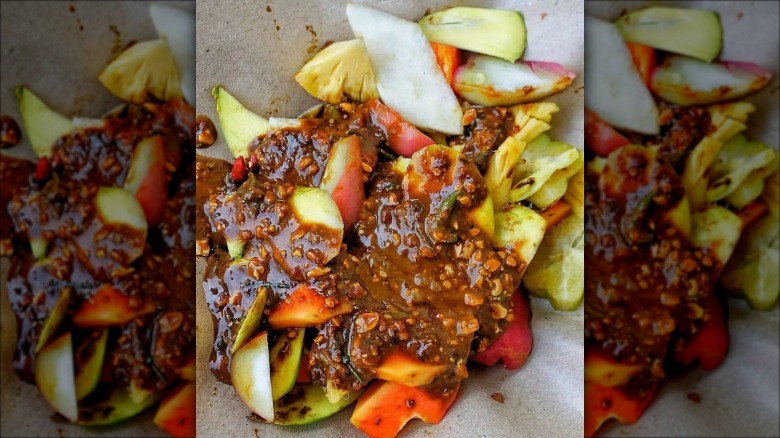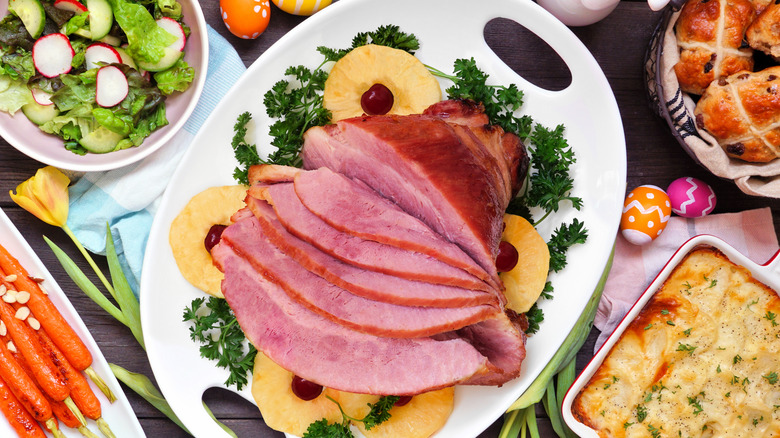13 Popular Ways Pineapple Is Eaten Around The World
Pineapple can be a delightful treat or an object of ridicule, especially when placed on a pizza. The prickly, acidic fruits originated in South America, and European explorers brought them back across the Atlantic. The most famous of these may have been Christopher Columbus, who is said to have "discovered" the plant in 1493 in Guadeloupe, where it had been eaten and enjoyed by the native people for centuries.
Love for this fruit spread, and, over the centuries, it has become an integral part of many now-classic dishes. In some parts of the world, such as Southeast Asia, it is almost impossible to think of a time without pineapples. Not only are they used for food, but in the Philippines, pineapples are also used to make piña fabric, a sheer but sturdy textile used to make everything from formal clothing to bags.
The pineapple really can do many things, so let's take a look at some of the popular ways it is eaten around the world.
1. Pineapple curry
Fruit curries are well-known in India and are often made with some variation in different regions. Many people in the country may avoid certain ingredients in their food for religious and cultural reasons, and fruit is a readily available substitute with few restrictions. Plenty of fruits can be used, and it's not uncommon to come across a fresh fruit curry made with pineapple. These curries are made with spices and are often paired with beans, lentils, meats, or paneer. This creates a dish that hits a diverse selection of flavor palates, being sweet, savory, and spicy all at once.
In some places, pineapple curries are included in religious and cultural festivals. For example, in the state of Kerala in southern India, a multi-fruit curry that includes pineapple is made for Onam Sadya, a harvest festival featuring vegetarian foods. In Mangalore, Brahmins make a fruit curry with pineapple for religious festivals.
2. Pineapple pizza
Oh, pineapple pizza, that much-hated, yet ever-present, pizza variety. It often draws sidelong glances, if not outright disgust, but that hasn't stopped this pizza from persevering and finding its way onto restaurants and dinner tables throughout North America.
Despite often being dubbed "Hawaiian pizza," pineapple pizza was not initially made in Hawaii. It is actually the invention of a Greek immigrant in Ontario, Canada, named Sam Panopoulos. Panopoulos and his brothers owned a restaurant that served pizza. In 1962, after some experimentation, Panopoulos created a pizza with canned pineapple and ham on it, calling it the Hawaiian after the brand of canned pineapples he used.
The pizza took off but remains controversial to this day. But as "Stranger Things" pizza boy Argyle says, "Fruit on your pizza is gnarly, you say? Well I say try before you deny." In 2017, the prime minister of Canada, Justin Trudeau, tweeted his support of this eclectic gastronomic go-to and stated his pride in it being a Canadian creation.
3. Pineapple Lumps
Pineapples can be added to sweet or savory treats, and in New Zealand, they are taken to the next level of sweetness with the addition of chocolate.
It all started in the 1950s with the Regina Confections company in Oamaru, New Zealand. The company already made pineapple-flavored marshmallow fish; however, making these left a lot of waste. So in order to use up the scraps, Regina decided to cut them into pieces and cover them in chocolate, thereby allowing the company to market them as a whole new treat. "Pineapple Chunks" were eventually renamed "Pineapple Lumps," and the candies were a huge hit and remain popular.
Pineapple Lumps are still available today, despite Regina Confections having been bought and sold multiple times over the ensuing decades. The lumps, now produced by Cadbury, are no longer made in New Zealand, but that does not stop them from being a uniquely Kiwi pineapple product.
4. Hummingbird cake
Using fruit in cakes is not altogether unusual. Upside-down cake is a popular dessert that often features pineapple. However, the hummingbird cake is a unique pineapple-filled Jamaican treat that sets itself apart from all other pineapple cakes. Don't worry — no hummingbirds are harmed in the making of this baked confection.
Hummingbird cake was likely invented in the late 1960s. Originally, the cake was called a Doctor bird cake after a variety of Jamaican hummingbirds commonly called Doctor birds. In a bid to get more tourists, the Jamaican tourism board sent press kits to the United States which included recipes for Doctor bird cake. The cake took off and soon showed up in kitchens across the southern U.S. In 1978, a recipe calling it "hummingbird cake" was printed in Southern Living.
The cake features crushed pineapple as well as banana and is spiced and topped with cream cheese frosting. Hummingbird cake is unusual in that there is more fruit in the dessert than flour. This makes it sweet and moist with just a little spice.
5. Pininyahang Manok
Pineapple has a tendency to lend itself to sweets, such as candies and cakes, but that doesn't stop it from being a part of popular savory dishes, as well. For example, in the Philippines, pininyahang manok is made by combining the flavors of pineapple and chicken. The dish is said to have originated in the Southern Luzon region's Batangas province. Among other things, the area is known for its pineapple plantations, which makes pineapple a natural addition to its regional cuisine.
Pininyahang manok is made by braising chicken, pineapples, and vegetables, often in either chicken stock or coconut milk. Variations of the dish abound. Different sauces are used, or the meat is marinated in pineapple juice first. The end result is a moist and flavorful dish that features an incredibly tender chicken. Pineapple makes a good meat tenderizer due to the presence of the enzyme bromelain, which helps to break down the fibers of the meat, making it deliciously tender.
6. Khao pad sapparot
"Khao pad sapparot" translates from Thai to "rice-fried pineapple" or "pineapple fried rice." It can be interpreted in recipes in a number of ways, but the end result is a deliciously fruity and savory fried rice dish.
This dish is exactly what it sounds like. It is a popular way to eat pineapples in Thailand, which has become one of the biggest producers of the fruit in the world. Fittingly, khao pad sapparot is often paired with shrimp, as Thailand is the sixth-largest shrimp producer in the world. The dish is also paired with vegetables and sauces and other flavors to round out the whole culinary experience.
One of the best parts of fried rice is that it's not difficult to make, and it's one of those dishes that's actually better when using leftover ingredients. In fact, using just-cooked rice can ruin fried rice. Use day-old rice instead.
7. Toast Hawaii
Pineapples are not indigenous to Hawaii, but that hasn't stopped them from becoming a symbol of the state and an integral part of its culture and history.
Toast Hawaiian does not come from the Pacific islands or anywhere near Hawaii, but rather from Germany. It's credited to Clemens Wilmenrod, who was Germany's first television celebrity chef. He gained popularity in the 1950s and is said to be the creator of Toast Hawaii. It's a piece of toast, topped with ham, cheese, and pineapple and finished decoratively with a cocktail cherry and served as an open sandwich. The end result is very similar to Hawaiian pizza in its appearance.
The easy-to-make dish became popular in Germany and, between the 1960s and 1980s, was a go-to meal in places like pubs, bowling alleys, and parties. Unlike Hawaiian pizza, this dish has remained a German phenomenon celebrating a certain Americanization of its culinary culture.
8. Perro caliente
Perro caliente is a hot dog, but it's not just any hot dog — it's the loaded hot dog to end all other hot dogs. Perro caliente is a Colombian street food that starts with a boiled hot dog. The hot dog is then topped with crumbled potato chips, garlic mayo, salsa rosada, and a pineapple sauce. Sometimes it even gets an additional topping of quail eggs. The result is an indulgent, filling food that is salty, sweet, and crunchy all at the same time.
Of course, there are other ways to top the hot dog. Hot dog vendor The Colombian Dog in Bridgeport, Connecticut, tops their perro caliente with potato chips, bacon, coleslaw, and fried cheese in addition to three sauces, one of which, of course, is pineapple sauce.
While this may seem to be a bold flavor combination in the United States, the classic tropical fruit and hot dog pairings can be also be found in New York City, where businesses such as Papaya King popularized them.
9. Fresca de piña
Fresca de piña, or aqua de piña is a type of agua fresca made with pineapple. Aguas frescas are non-alcoholic beverages made with fruits, water, and sugar. They're found in Mexico, often sold by street vendors or in convenience stores, and they pair well with spicy Mexican food. There are many popular flavors of aguas frescas, one of which is pineapple.
To make the drink, water, sugar, and pineapple are mixed together to blend perfectly into a cool, refreshing, and lightly sweet fruity drink. Fresca de piña also takes on a beautiful yellow color, the same shade as the whole fruit. "Fresca" is Spanish for "fresh," which makes fresca de piña "fresh pineapple," which obviously makes it sound as refreshing as it tastes.
The drink is simple to make at home — just don't confuse it with the soft drink brand Fresca, which traditionally makes citrusy drinks but does not offer a pineapple-flavored beverage.
10. Canh Chua
Canh chua is a Vietnamese sweet and sour soup that perfectly blends a variety of flavors together. The dish hails from the Mekong Delta. It may be surprising to some people to see a soup with pineapple in it, but it works really well. Traditionally, canh chua is made with fish, tomatoes, and pineapple and uses a tamarind base, which helps to give the soup its complimentary sour notes. Both tomatoes and pineapple work together well canh chua as, on their own, the fruits are both sweet and tangy.
There are lots of variations on the dish, some made with different types of meat or, as this canh chua recipe suggests, using tofu instead of fish to offer a vegetarian-friendly option. These proteins, combined with the flavorful herbs and vegetables, all blend together to create a well-balanced soup. Canh chua can be served over rice or with rice noodles, and it's often served cold as a way to avoid overheating during the hot summers in Vietnam.
11. Fenglisu
Fenglisu is a traditional Taiwanese cake. It may look simple from the outside, but do not be deceived. This cake is packed with flavor. The outside layer is made with a butter cake pastry, and the inside is filled with a delicious pineapple jam, creating a sweet and heavenly flavor combination.
During the Japanese colonial era of Taiwan, which started in the late 1800s and ended in the mid-1940s, Taiwan produced tons of pineapple. Production shifted downward as World War II forced the repurposing of some pineapple-growing plots. After Taiwan was freed from Japanese occupation, though, it rebounded. At one point, Taiwan was the largest pineapple producer in the world, which naturally led to a lot of pineapple treats being created, including fenglisu.
Today, the annual Taipei Pineapple Cake Festival, which began in 2006, celebrates the delicious cake. Well-known company Chia Te bakery is one of the top commercial producers of the cake and has won multiple awards for its fenglisu at the festival.
12. Rujak
Let's be clear about this: Fruit salad does not have to be boring. It's not uncommon to find pineapple on a fruit tray at any given grocery store in the United States, or to find it mixed into the classic Southern dish ambrosia salad, a sweet fruit salad with marshmallows and whipped topping. Other countries, though, take pineapple fruit salad and pump it up without the marshmallows.
A good example of this is rujak. Rujak (also spelled "rojak") is a fruit salad found in Indonesia as well as Malaysia and Singapore. In all of its regional varieties, rujak is served with a dark and sticky sauce and topped with peanuts.
The sauce is made from a fermented prawn paste, chili paste, sugar, and limes, which makes for a sweet and sour and slightly spicy sauce. The base is often a mix of fruit and vegetables, including pineapple. The pineapple adds to the sweet and sour notes of the salad and brings a juicy note to it all. Rujak is complex, with a diverse flavor palate and assorted textures with a hint of spice.
13. Hamonado
Think Hawaii owns the market on pork and pineapple? Well, think again. Just because the Hawaiian Islands may be the first place that comes to mind when we discuss pineapple and ham together doesn't mean they're the only ones doing it. In the Philippines, a dish known as hamonado is pork made with pineapples.
As we've established, pineapple makes an excellent marinade for meat. Pineapple contains the enzyme bromelain, which acts as a meat tenderizer, breaking down the meat to make it soft and supple. In addition to pineapple, the dish often includes soy sauce as an ingredient, which helps to round out the flavor. Hamonado can be enjoyed anytime but is also found as part of Noche Buena festivities. Celebrating Noche Buena, aka Christmas Eve, is a long-standing tradition in the Philippines due to Spanish colonization. Ham is not an unusual choice for Christmas celebrations in many places around the world, but in the Philippines, ham dishes often incorporate pineapples.
